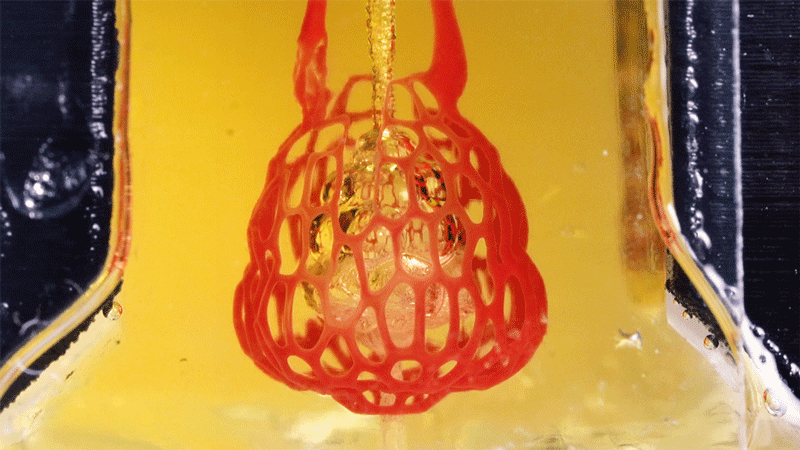![[Image: Brandon Martin / Rice University]](https://fabbaloo.com/wp-content/uploads/2020/05/lungMimic_breathe2_img_5eb0981b953e6.gif)
What do you get when a design studio collaborates with bioengineers?
One of the most common themes we see today as Industry 4.0 takes shape is the collaboration needed to make real, tangible advances. Whatever you want to call that collaboration — a partnership, teamwork, cross-disciplinary think tanks, co-creation — the need to work together is ever more in the spotlight.
One debate that I find interesting is a simple one: do we talk about STEM or STEAM? Science, technology, engineering — arts (?) — and mathematics make up the focus of many educational curricula today. As a theatre major working today in technology, I’m very much a proponent of STEAM over STEM: we need the arts. We need the thinking that comes from artistic endeavors.
A three-year collaborative relationship between design studio Nervous System and researchers at Rice University, the University of Washington, Duke University, and Rowan University highlights the very real ways in which art and technology go beautifully hand-in-hand.
Nervous System is a prolific studio behind some incredible designs we’ve seen over the years. They’ve also already been behind some important messaging for the industry at large. No wonder; their entire basis is in applying broader thinking. The studio’s description explains:
“Nervous System is a generative design studio that works at the intersection of science, art, and technology.”
I’ve been most familiar with Nervous Studio’s design work in fashion and jewelry — but now they’ve released detail of work in creating vascular networks for 3D printed organs.
They say:
“We founded Nervous System in 2007 with the goal of adapting algorithms and strategies from nature into new ways to design products; but we never imagined we’d have the opportunity to apply that back to designing living things.”
Nervous System co-founders Jessica Rosenkrantz and Jesse Louis-Rosenberg are now also co-authors on an intriguing interdisciplinary article created with the university teams. The piece, published earlier this week in Science magazine, is titled “Multivascular networks and functional intravascular topologies within biocompatible hydrogels.”
The work brought the Nervous System designers full circle, in a way. Their art has been inspired by nature, created using generative systems, and now that skill is being used to in turn make new living things.
Obviously there are a lot of complexities in creating living organs. The body is ridiculously complex, with organs requiring “intricate vascular networks” to keep operations running. These are of course all networked together to work in the entire functional body. Progress made in bioprinting is leading, slowly, to what may be a new reality in 3D printing personalized new organs — but it’s a long road yet ahead.
The project Nervous System worked on specifically focused on these intricate vascular systems. They explain:
“Our goal is to create software which enables scientists to design customized multi-vascular structures for 3D-printed organs. Nervous System collaborated with the Miller Lab to design and generate these complex multivascular networks and materialize them in soft hydrogels for the first time.”
Riche University’s Miller Lab is run by Jordan Miller, who reached out to Nervous System in February 2016. He had found some of their branching sculptures on Thingiverse and thought there might be the possibility to bring those types of structures and that level of experience into the lab.
Nervous System explains some of the project’s reach:
“Our role is just a small part of a large team led by Jordan Miller at Rice University. The Miller Lab is developing the bioengineering, 3D-printing technology, cell culturing, and analysis tools that make these designs possible to realize. Particularly, they developed a new 3D-printing workflow compatible with live cells called SLATE (stereolithography apparatus for tissue engineering). The SLATE printer can embed live cells into soft gels containing very small, intricate blood vessels down to 300 microns in diameter. Hydrogels printed in only minutes by SLATE can function as lung-like networks with entangled air / blood networks.”
More on the research:
In 3D printing, we often see more collaborations focusing on bringing in specific software suites and capabilities. Software is a particular need for the industry, and we’re seeing an increasing amount of partnerships and new product introductions focusing on this area.
Nervous System’s experience in this area, along with biomimetic design thinking, made the studio an excellent fit to the work these universities’ researchers were doing in the lab.
Sometimes collaborations that may at first glance — a design studio and bioengineering research — seem very disparate. But really, it’s these types of cross-disciplinary experiences coming together that will lead to some of the greatest advances we’ll see.
Via Nervous System






